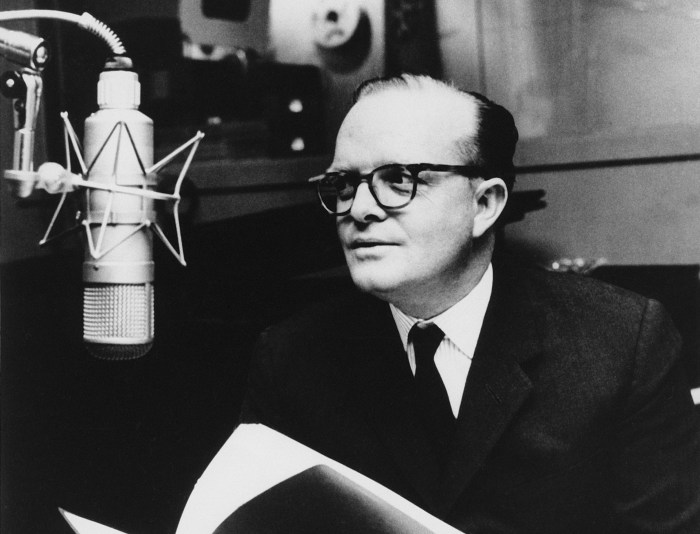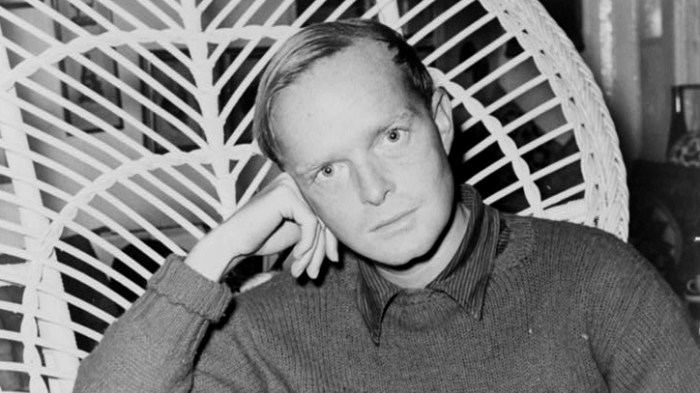Truman Capote, a literary icon of the 20th century, captivated readers with his poignant prose and controversial true-crime accounts. From his iconic novella “Breakfast at Tiffany’s” to his groundbreaking “In Cold Blood,” Capote’s unique writing style and complex personal life continue to fascinate and provoke.
Through his literary brilliance, Capote not only shaped American literature but also left an enduring mark on popular culture. His ability to delve into the human psyche, explore societal norms, and challenge ethical boundaries has cemented his legacy as a literary giant.
Early Life and Career

Truman Capote’s extraordinary journey began in New Orleans, Louisiana, on September 30, 1924. As a child, he developed an insatiable passion for storytelling, spending countless hours lost in the world of books. His early writings showcased a remarkable talent, earning him recognition as a prodigious writer at a young age.Growing
up in the South, Capote was deeply influenced by the region’s rich literary tradition and its distinct social hierarchy. His keen observation of human behavior and his ability to capture the nuances of Southern society would later become hallmarks of his writing.
“Breakfast at Tiffany’s”
Truman Capote’s iconic novella, “Breakfast at Tiffany’s,” is a literary masterpiece that has captured the hearts and minds of readers for decades. With its captivating characters, poignant themes, and enduring appeal, the novella has become a cultural phenomenon that continues to resonate with audiences today.
Themes
“Breakfast at Tiffany’s” explores a range of complex themes, including:
- Loneliness and Isolation: The novella delves into the loneliness and isolation experienced by its protagonist, Holly Golightly. Despite her glamorous facade, Holly is a deeply insecure and vulnerable character who struggles to connect with others.
- The Search for Meaning: Holly’s journey is marked by a constant search for meaning and purpose in her life. She engages in a series of superficial relationships and experiences, but ultimately remains unfulfilled.
- The Importance of Authenticity: The novella emphasizes the importance of being true to oneself. Holly’s struggle with her identity and her attempts to conform to societal expectations ultimately lead to her unhappiness.
Characters
“Breakfast at Tiffany’s” features a cast of unforgettable characters, each of whom contributes to the novella’s rich tapestry:
- Holly Golightly: The enigmatic and charming protagonist of the novella, Holly is a complex and flawed character. She is both alluring and aloof, and her enigmatic nature has captivated readers for generations.
- Paul Varjak: The narrator of the novella, Paul is a young writer who becomes Holly’s confidant and friend. He is drawn to Holly’s vulnerability and resilience, and his perspective provides a unique insight into her character.
- O.J. Berman: Holly’s eccentric and flamboyant friend, O.J. is a wealthy Brazilian playboy who provides comic relief to the novella. He is a loyal and supportive friend to Holly, despite her often-unpredictable behavior.
“In Cold Blood”

Truman Capote’s masterpiece, “In Cold Blood,” was a groundbreaking true-crime novel that redefined the genre. Capote meticulously researched the 1959 murders of the Clutter family in Holcomb, Kansas, and spent years crafting a gripping and disturbing account of the crime and its aftermath.
Genesis of “In Cold Blood”
Capote was drawn to the Clutter murders after reading a brief article about the crime in The New York Times. He traveled to Holcomb and spent months interviewing the townspeople, the investigators, and eventually the two murderers, Perry Smith and Richard Hickock.
Capote’s goal was not just to report the facts of the case but to understand the psychological motivations of the killers and the impact of the crime on the community.
Ethical Implications
Capote’s involvement with the murderers raised ethical concerns. He spent so much time with Smith and Hickock that he developed a close relationship with them. Some critics accused Capote of exploiting the killers for his own literary gain, while others argued that his empathy allowed him to provide a deeper understanding of their actions.
Despite the ethical questions, “In Cold Blood” remains a powerful and influential work of literature. Capote’s meticulous research and vivid writing style created a gripping narrative that brought the Clutter murders and their aftermath to life. The novel’s impact on the true-crime genre is undeniable, and it continues to be studied and discussed by readers and scholars alike.
Literary Style and Techniques

Truman Capote’s writing is characterized by its meticulous attention to detail, vivid imagery, and a keen eye for the nuances of human nature. His unique blend of journalism and fiction, known as the “nonfiction novel,” allowed him to create works that were both factually accurate and emotionally resonant.Capote’s
prose is often lyrical and evocative, with a distinctive voice that is both intimate and authoritative. He employs a variety of literary techniques, including:
Figurative Language
Capote makes extensive use of metaphors, similes, and personification to create vivid and memorable images. For example, in “In Cold Blood,” he describes the Clutter family home as a “glass beehive” and the murderers, Richard Hickock and Perry Smith, as “wolves.”
These vivid images help the reader to visualize the events and characters in a visceral way.
Point of View
Capote’s use of point of view is particularly noteworthy. In “In Cold Blood,” he adopts the perspectives of both the victims and the killers, providing a complex and nuanced account of the crime. This multi-perspectival approach allows the reader to understand the motivations and emotions of all the characters involved.
Objectivity and Subjectivity
Capote’s writing is often characterized by a tension between objectivity and subjectivity. While he strives to present the facts of the case in “In Cold Blood,” he also includes his own personal observations and interpretations. This tension between objectivity and subjectivity adds depth and complexity to his work.
Dialogue
Capote’s use of dialogue is highly effective in creating realistic and engaging characters. He records the speech patterns and mannerisms of his subjects with great accuracy, bringing them to life on the page. For example, in “Breakfast at Tiffany’s,” Holly Golightly’s distinctive voice and personality are vividly captured through her dialogue.
Relationships and Personal Life
Truman Capote was known for his complex and often tumultuous relationships. He had a close friendship with Harper Lee, the author of “To Kill a Mockingbird,” and was a member of the so-called “Rat Pack,” a group of celebrities and entertainers that included Frank Sinatra, Dean Martin, and Sammy Davis Jr.
Capote’s relationships with other writers were often fraught with rivalry and envy. He famously feuded with Gore Vidal and Norman Mailer.Capote’s personal experiences had a profound impact on his writing. His childhood was marked by poverty and instability, and he was often bullied by other children.
These experiences gave him a deep understanding of the human condition and a keen eye for the complexities of human relationships.
Friendships and Feuds
Capote cultivated a wide circle of friends and acquaintances, including celebrities, writers, and socialites. He was known for his charm and wit, and he was often the life of the party. However, he could also be manipulative and cruel, and he often betrayed the trust of his friends.One
of Capote’s most famous friendships was with Harper Lee. The two met in the early 1950s, and they quickly became close friends. Capote helped Lee to edit and revise “To Kill a Mockingbird,” and he was instrumental in its success.
However, their friendship was strained in later years, and they eventually drifted apart.Capote was also a member of the “Rat Pack,” a group of celebrities and entertainers that included Frank Sinatra, Dean Martin, and Sammy Davis Jr. Capote was often the outsider in this group, and he was sometimes resentful of the attention that his friends received.Capote’s
relationships with other writers were often fraught with rivalry and envy. He famously feuded with Gore Vidal and Norman Mailer. Vidal once called Capote a “social climber,” and Mailer said that Capote was “a dwarf.”
Personal Demons
Capote’s personal life was marked by addiction and self-destructive behavior. He was a heavy smoker and drinker, and he often took drugs. He also struggled with depression and anxiety.Capote’s addictions and self-destructive behavior had a negative impact on his health and his career.
He died in 1984 at the age of 59 from liver failure.
Literary Legacy
Truman Capote’s groundbreaking literary contributions continue to shape American literature. His innovative writing techniques and exploration of complex human emotions have had a profound impact on generations of authors.
Capote’s ability to seamlessly blend fact and fiction, as exemplified in “In Cold Blood,” has inspired contemporary writers to explore the boundaries of non-fiction storytelling. His candid portrayal of the human condition, with its vulnerabilities and complexities, has also influenced the development of character-driven narratives.
Enduring Influence
- Capote’s focus on empathy and the subjective experience of characters has encouraged contemporary authors to delve into the psychological motivations and perspectives of their protagonists.
- His use of lyrical prose and attention to sensory details has set a precedent for immersive and evocative storytelling, influencing writers such as Donna Tartt and Jeffrey Eugenides.
- Capote’s fearless exploration of taboo subjects and unconventional themes has paved the way for contemporary authors to tackle challenging topics with honesty and authenticity.
Adaptations and Cultural Impact
Truman Capote’s works have been widely adapted into various media, including films, television shows, and stage productions. These adaptations have played a significant role in shaping Capote’s cultural legacy, bringing his stories to a broader audience and solidifying his position as a literary icon.
The following table provides a comparative overview of some of the most notable adaptations of Capote’s works:
| Adaptation | Medium | Release Date | Notable Features |
|---|---|---|---|
| Breakfast at Tiffany’s | Film | 1961 | Starring Audrey Hepburn as Holly Golightly, capturing the film’s iconic fashion and lifestyle. |
| In Cold Blood | Film | 1967 | A faithful adaptation of the novel, known for its groundbreaking documentary-style approach. |
| The Grass Harp | Film | 1995 | A whimsical adaptation of Capote’s early novel, featuring an ensemble cast including Sissy Spacek and Jack Lemmon. |
| Music for Chameleons | Television series | 1980 | A short-lived but critically acclaimed adaptation of Capote’s novel, featuring a young Sting in a supporting role. |
| Tru | Stage play | 1989 | A one-man show based on Capote’s life, written by Jay Presson Allen and starring Robert Morse. |
These adaptations have not only brought Capote’s works to a wider audience but have also influenced popular culture. The film adaptation of Breakfast at Tiffany’s , in particular, has become a cultural touchstone, with its iconic characters and memorable scenes shaping perceptions of New York City and American high society.
Furthermore, the adaptations have helped to preserve Capote’s legacy as a literary master. By bringing his stories to the screen and stage, they have ensured that his work continues to be accessible and relevant to new generations of readers and viewers.
Controversies and Criticism
Truman Capote’s work and personal life were not without their share of controversies and criticism. His journalistic methods in “In Cold Blood” raised ethical concerns, and his portrayal of society’s marginalized groups drew accusations of insensitivity and exploitation.
One of the most significant controversies surrounding Capote’s work was the use of fictionalized techniques in his nonfiction book “In Cold Blood.” Capote’s portrayal of the murderers, Perry Smith and Richard Hickock, as sympathetic characters sparked debate about the ethics of blurring the lines between fact and fiction in journalism.
Criticism of Literary Methods
Capote’s writing style and techniques also drew criticism. Some critics accused him of sensationalizing his subjects and exploiting their suffering for entertainment value. Others criticized his use of literary devices, such as flashbacks and stream-of-consciousness, as being manipulative and distracting from the truth.
Personal Controversies
Capote’s personal life was also marked by controversy. His lavish lifestyle, drug use, and flamboyant personality often overshadowed his literary achievements. Some critics accused him of being more interested in celebrity than in substance.
Exploitation of Vulnerable Groups
Capote’s portrayal of marginalized groups, particularly in “Breakfast at Tiffany’s,” drew accusations of insensitivity and exploitation. Critics argued that he exoticized and commodified the experiences of these groups for his own gain.
Unpublished Works and Posthumous Releases
Truman Capote left behind a treasure trove of unpublished works and posthumous releases that have shed light on his creative process and deepened our understanding of his legacy. These works include unfinished novels, short stories, essays, and personal correspondence.
Unfinished Novels
One of Capote’s most anticipated unfinished novels was “Answered Prayers,” a sprawling work that promised to expose the secrets and scandals of high society. Despite years of work, the novel remained incomplete at the time of his death. However, excerpts and fragments of the novel have been published posthumously, offering tantalizing glimpses into Capote’s unfinished masterpiece.
Short Stories and Essays
Capote also left behind a collection of unpublished short stories and essays. These works showcase his versatility as a writer, exploring themes of love, loss, and the complexities of human nature. Some of these pieces have been published posthumously in collections such as “The Dogs Bark” and “Music for Chameleons.”
Personal Correspondence
Capote’s personal correspondence with friends, lovers, and colleagues provides invaluable insights into his life and creative process. His letters reveal his wit, his struggles, and his relationships with some of the most famous figures of his time. Selected letters have been published in collections such as “Letters to a Friend” and “Too Brief a Treat.”
Significance
These unpublished works and posthumous releases have played a significant role in shaping our understanding of Truman Capote. They have provided a deeper glimpse into his creative mind, revealing the unfinished ideas, personal struggles, and literary brilliance that defined his life and work.
By studying these materials, we can better appreciate the complexity of his artistry and the enduring legacy he has left behind.
Recommended Reading
For those eager to delve deeper into the fascinating life and literary legacy of Truman Capote, the following books and articles offer invaluable insights and perspectives:
-
“Truman Capote: A Biography” by Gerald Clarke
This comprehensive biography meticulously chronicles Capote’s extraordinary life, from his childhood in Alabama to his rise to literary stardom and subsequent struggles.
-
“Capote: A Biography” by Jay Parini
Parini’s insightful work explores Capote’s complex personality, his literary genius, and the controversies that surrounded his life.
-
“Conversations with Capote” by Lawrence Grobel
This collection of interviews provides a firsthand glimpse into Capote’s thoughts, feelings, and writing process.
-
“The Complete Stories of Truman Capote”
An essential collection showcasing Capote’s mastery of the short story form, including classics like “Children on Their Birthdays” and “A Christmas Memory.”
-
“The Art of Fiction: Truman Capote” by The Paris Review
This interview with Capote delves into his writing techniques, influences, and philosophy of fiction.
Final Thoughts
Truman Capote’s legacy extends far beyond the pages of his books.
His contributions to literature, true crime, and popular culture have left an indelible imprint on our collective consciousness. His works continue to inspire, challenge, and captivate readers, ensuring that his literary genius will endure for generations to come.
Frequently Asked Questions
What is Truman Capote’s most famous work?
“In Cold Blood,” a groundbreaking true-crime novel that explores the psychological and ethical complexities of a brutal murder.
What is the significance of “Breakfast at Tiffany’s”?
A timeless novella that captures the allure and loneliness of New York City through the eyes of a young woman.
What is Truman Capote’s writing style known for?
His distinctive “nonfiction novel” style, which blends elements of fiction and journalism to create a compelling and immersive narrative.

